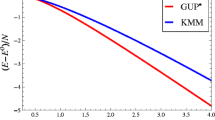Abstract
Bohr and Heisenberg suggested that the thermodynamical quantities of temperature and energy are complementary in the same way as position and momentum in quantum mechanics. Roughly speaking their idea was that a definite temperature can be attributed to a system only if it is submerged in a heat bath, in which case energy fluctuations are unavoidable. On the other hand, a definite energy can be assigned only to systems in thermal isolation, thus excluding the simultaneous determination of its temperature. Rosenfeld extended this analogy with quantum mechanics and obtained a quantitative uncertainty relation in the form ΔU Δ(1/T) ≥ k, where k is Boltzmann's constant. The two “extreme” cases of this relation would then characterize this complementarity between isolation (U definite) and contact with a heat bath (T definite). Other formulations of the thermodynamical uncertainty relations were proposed by Mandelbrot (1956, 1989), Lindhard (1986), and Lavenda (1987, 1991). This work, however, has not led to a consensus in the literature. It is shown here that the uncertainty relation for temperature and energy in the version of Mandelbrot is indeed exactly analogous to modern formulations of the quantum mechanical uncertainty relations. However, his relation holds only for the canonical distribution, describing a system in contact with a heat bath. There is, therefore, no complementarily between this situation and a thermally isolated system.
Similar content being viewed by others
REFERENCES
N. Bohr, Collected Works, J. Kalckar, ed. (North-Holland, Amsterdam, 1985), Vol. 6, pp. 316–330, 376-377.
A. Pais, Niels Bohr's Times in Physics, Philosophy, and Polity (Clarendon Press, Oxford, 1991).
B. Mandelbrot, IRE Trans. Inform. Theory IT-2, 190 (1956).
B. Mandelbrot, Ann. Math. Stat. 33, 1021 (1962).
B. Mandelbrot, J. Math. Phys. 5, 164 (1964).
L. Rosenfeld, in Ergodic Theories, P. Caldirola, ed. (Academic Press, New York, 1961), p. 1.
B. Lavenda, Int. J. Theor. Phys. 26, 1069 (1987).
B. Lavenda, Int. J. Theor. Phys. 27, 451 (1988).
B. Lavenda, J. Phys. Chem. Sol. 49, 685 (1988).
B. Lavenda, Statistical Physics: A Probabilistic Approach (Wiley, New York, 1991).
J. Lindhard, in The Lesson of Quantum Theory, J. de Boer, E. Dal, and O. Ulfbeck, eds. (North-Holland, Amsterdam, 1986).
F. Schlögl, J. Phys. Chem. Sol. 49, 679 (1988).
H. Feshbach, Phys. Today 40, 9 (1987).
Ch. Kittel, Phys. Today 41, 93 (1988).
B. Mandelbrot, Phys. Today 42, 71 (1989).
L..D. Landau and E. M. Lifshitz, Statistical Physics (Pergamon Press, London, 1959).
A. S. Holevo, Probabilistic and Statistical Aspects of Quantum Theory (North-Holland, Amsterdam, 1982).
E. R. Caianiello, in Frontiers of Non-Equilibrium Statistical Physics, G. T. Moore and M. O. Scully, eds. (Plenum, New York, 1986), pp. 453–464.
S. L. Braunstein, in Symposium on the Foundations of Modern Physics 1993, P. Busch, P. Lahti, and P. Mittelstaedt, eds. (World Scientific, Singapore, 1993), p. 106.
A. I. Khinchin, Mathematical Foundations of Statistical Mechanics (Dover, New York, 1949).
A. Martin-Löf, Statistical Mechanics and the Foundations of Thermodynamics (Springer, Berlin, 1979).
H. Jeffreys, Theory of Probability ( Clarendon Press, Oxford, 1966), 3rd ed.
I. Hacking, Logic of Statistical Inference (Cambridge University Press, Cambridge, 1965).
T. Seidenfeld, Philosophical Problems of Statistical Inference, (Reidel, Dordrecht, 1979).
A.W. F. Edwards, Likelihood ( John Hopkins University Press, Baltimore, 1992).
See T. C. P. Chui, D. R. Swanson, M. J. Adriaans, J. A. Nissen, and J. A. Lipa, Phys. Rev.Lett. 69(21), 3005 ( 1992).
W. K. Wootters, Phys. Rev. D 23, 357 (1981).
J. Hilgevoord and J. Uffink, Found. Phys. 21, 323 (1991).
J. Uffink, Am. J. Phys. 61, 935 (1993).
J.-M. Lévy-Leblond, Phys. Lett. A. 111, 353 (1985).
L. Mandelstam and I. Tamm, J. Phys. (USSR) 9, 249 (1945).
H. B. Prosper, Am. J. Phys. 61, 54 (1993).
Rights and permissions
About this article
Cite this article
Uffink, J., van Lith, J. Thermodynamic Uncertainty Relations. Foundations of Physics 29, 655–692 (1999). https://doi.org/10.1023/A:1018811305766
Issue Date:
DOI: https://doi.org/10.1023/A:1018811305766




